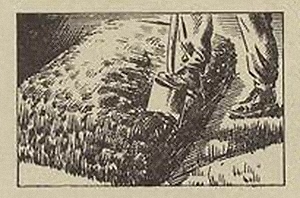What is GOOD TILTH?
 It is the top foot or so of soil got into a “crumby” condition. The “crumbs” hold a lot of water on their surfaces and let surplus water drain away quickly through the big pore spaces between them. These spaces supply air, which the roots need as well a water. When rain falls, the uppermost “crumbs” soak it up till they are saturated––like blotting paper dipped in water. Then the surplus soaks downward to the “crumbs” immediately below, and so on.
It is the top foot or so of soil got into a “crumby” condition. The “crumbs” hold a lot of water on their surfaces and let surplus water drain away quickly through the big pore spaces between them. These spaces supply air, which the roots need as well a water. When rain falls, the uppermost “crumbs” soak it up till they are saturated––like blotting paper dipped in water. Then the surplus soaks downward to the “crumbs” immediately below, and so on.
Each “crumb” is like a little sponge. If there is more rain than the “crumbs” can hold, the bigger spaces between them allow the extra water to drain quickly downward and the soil does not become waterlogged. The roots of plants in “crumby” soil can grow easily down the air spaces between the “crumbs.” All around them are “crumbs” containing the water the roots need.
At the tips of the roots are tiny hairs which absorb water. So you will see how important it is that the tips of the roots should not be damaged when planting out.
THE VALUE OF HUMUS
What is “humus”? It is a formless material made up of tiny particles produced from the remains of plants and animals when they have decayed. It helps to maintain a “good tilth” and thus ensures good aeration. But it does more; it helps the soil to remain moist and provides plant foods.
‘Organic’ MANURES
“Organic” manures help to make clay soils lighter and sandy soils better able to hold water. “Organics” are so called because they are formed from something that was living – plants or animals, or both.
 What are they? The best known are farmyard manure and other animal droppings, such as pig and poultry manure. Other “organic” manures include guano, hoof and horn meal, dried blood, meat and bone meal, shoddy and soot. But market gardeners make great use of these “organics” and it may not be easy for the amateur grower to get them.
What are they? The best known are farmyard manure and other animal droppings, such as pig and poultry manure. Other “organic” manures include guano, hoof and horn meal, dried blood, meat and bone meal, shoddy and soot. But market gardeners make great use of these “organics” and it may not be easy for the amateur grower to get them.
You yourself can make “organic” manures, either in the form of green manure––a green crop, such as mustard, grown specially for digging in – or compost, which you can make from waste garden material.
Notes on Wool Shoddy & Soot Use in the Garden:
Shoddy refers to wool shoddy, a waste product of the woollen industry, being the fibres that were too short or poor quality or dirty to be useful. It made a slow-release nitrogen fertiliser that also held water well making it a useful mulch. With the decline in the wool industry, the availability of shoddy fell away.
Wool is now being sold as a premium product to deter slugs.
The principle benefit of soot was to darken the soil so it absorbed more sunlight and warmed up better in the spring. It’s use remained common until natural gas replaced ‘King Coal’ as the popular heating fuel and chimney soot was no longer easily available.
There are some concerns about using coal chimney soot as it may contain noxious substances but my grandfather swore it was the sovereign material to add to the onion bed for bumper crops.


